An Investigation of Pensioner Employment
The report explores the drivers behind the consistent increase in pensioner employment over the past decade, including throughout the last recession. It discusses the employment characteristics and socio-economic conditions of pensioners who continue to w
Economic And Social Conditions Of Pensioners
The following section analyses available data on the economic and social conditions of pensioners. These pensioners are not necessarily in work or over 65.
Earnings represent a smaller proportion of income for low-income pensioner households
As illustrated in the following charts, the proportion of income (before housing costs) from earnings is higher for pensioners at the top end of the income distribution reaching an average of £461 per week for pensioner couples and an average of £157 for single pensioners. For households within the top 20% total income, earned income accounts for 34% of pensioner couples' income and 20% of single pensioners' income. These households also have a higher proportion of income from private wealth, such as private investment and occupational pensions.
Pensioners in the bottom 20% of household total incomes receive a very limited proportion of their income from earnings - couple pensioners earn an average of £6.50 per week, while single pensioners earn an average of £4. In relative terms this accounts for 2.4% of pensioner couples' total income and 2.2% of single pensioners' total income. These households are predominantly reliant on benefits which in relative terms account for over 80% of total income for both pensioner couples and singles.
Whilst income from earnings for pensioner couples shows large increases in both absolute and relative terms as we move up the income distribution, for single pensioners income from earnings in the middle quintile is more than twice that of the next highest quintile. It is likely that pensioners at the lower end of the income distribution face greater barriers to accessing good working conditions.
Figure 26: Sources of mean gross income of pensioner households by quintile in the income distribution BHC - absolute level
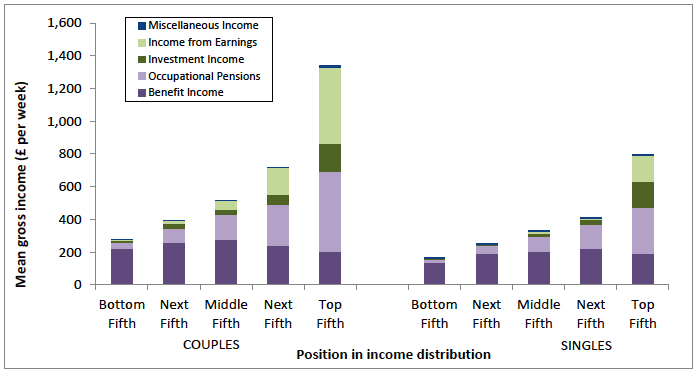
Source: Based on data selection from Households Below Average Income, £ per week 2013/14 prices
Figure 27: Sources of mean gross income of pensioner households by quintile in the income distribution BHC - percentage share
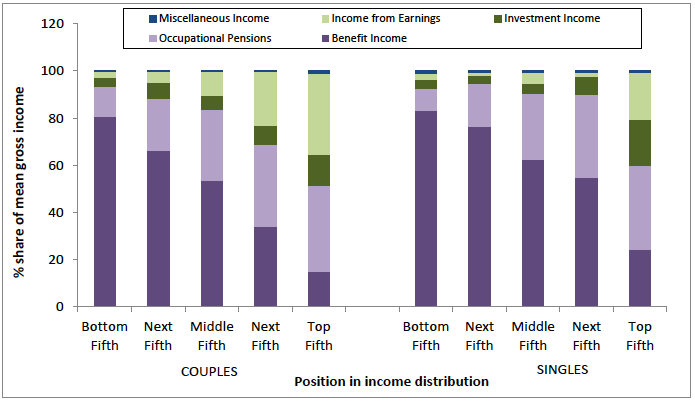
Source: Based on data selection from Households Below Average Income, £ per week 2013/14 prices
Many low income pensioners do not claim eligible benefits
Pension credit contains two parts: guarantee credit and savings credit. Guarantee credit provides those who have reached the qualifying age with a top-up to bring their income up to a minimum standard - in April 2016 this was set at £151.20 a week for a single person or £230.85 a week for those living with a partner.
The savings credit is an extra payment for people who have made modest provision for their retirement through an occupational or personal pension or savings. In April 2016, the savings credit was up to £14.82 a week for a single person and £17.43 a week for those living with a partner. Savings credit is being abolished with the introduction of the Single Tier Pension.
Whilst pension credit is targeted at low income households, there are surprisingly low levels of take up amongst those eligible for it. In 2013/14, only 61 to 64% of eligible pensioners were estimated to claim pension credit [13] . Based on 2009/10 data, take-up of the guarantee credit, paid to the poorest pensioners, was between 73% and 80%. [14]
Research suggests that the primary barrier to claiming is perceived ineligibility with perceived stigma as a secondary barrier [15] . However this is unlikely to have a negative impact on pensioners who wish to work. Claiming pension credit would help improve the wellbeing of low income pensioners who cannot work.
Pensioner couples can (nearly) reach the minimum income standard
Research on the minimum income standard for the UK by the Joseph Rowntree Foundation has indicated that a pensioner couple was £10 short of reaching Minimum Standard of Living ( MIS) in 2015 [16] . This figure is relatively low when compared against working age single people (£110 short), lone parents (£118 short) and couple parents (£197 short). There is no analysis provided on single pensioners.
The MIS is based on research into the items that members of the public think should be covered by a household budget in order to achieve a minimum socially acceptable standard of living. Inflation, increases in benefits, above inflation increases to NMW and increases in the personal tax allowance have all been considered when estimating the MIS budgets.
In contrast to working-age households, couple pensioners are guaranteed an income almost equal to MIS under pension credit. A pensioner couple had income £11 above MIS in 2008. This has declined slightly in 2015 (£10 short) due to the safety net for pension credit rising in line with inflation (Consumer Prices Index) but MIS has risen faster in recent years.
Decrease in pensioner poverty over the last decade is steeper than in child and working age adult poverty
As illustrated in the following chart, over the last decade, the proportion of pensioners in Scotland in relative poverty Before Housing Costs ( BHC) has fallen 8 percentage points from 23% in 2002/03 to 15% in 2013/14. The fall in pensioner poverty over the last decade has been steeper than comparable falls for children and working age adults. However, in 2013/14 it remained unchanged from the previous year at 15%. Whilst relative poverty After Housing Costs ( AHC) [17] has followed a decreasing trend over the last decade, in 2013/14 it increased by one percentage point, compared with the previous year, to 12%. The respective figure for the UK is 14%. In 2013/14, there were 80,000 pensioners in Scotland living in material deprivation. This figure represents 9% of the pensioner population and has increased by one percentage point from the previous year.
Relative pensioner poverty had been decreasing due to higher upratings in pensioner benefits compared to earnings. Between 2009/10 and 2013/14 basic state pension ( BSP) income has increased faster than earnings for working age households, and at a faster rate than for most other benefit and tax credit income. However, in 2013/14, the BSP was uprated by 2.5% under the triple lock [18] , a considerably lower increase compared to 5.2% uprate in the previous year. This could potentially explain the unchanged relative poverty BHC and the increased relative poverty AHC in 2013/14.
Figure 28: Relative poverty and material deprivation - pensioners, Scotland
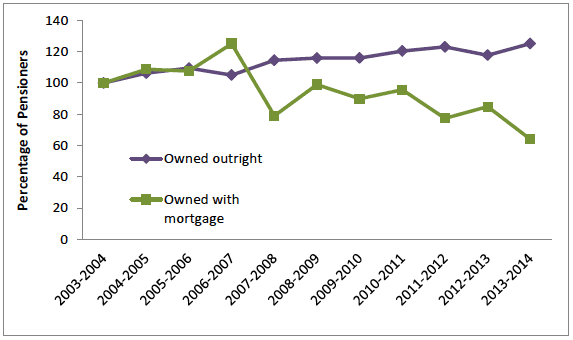
Source: Households Below Average Income dataset, Department for Work and Pensions
More pensioners owning properties outright
Looking at trends in mortgage debt of pensioner households in Scotland in Figure 29, it is evidenced that the proportion of pensioners owning properties with mortgages has been following a decreasing trend. In 2013/14, 4% of pensioner households owned a property with a mortgage decreasing by 1.2 percentage points from the previous year. Over the same period the proportion of pensioner households owning properties outright has been increasing. In 2013/14, 72% of pensioners owned properties outright, an increase from 67% the previous year.
Figure 29: Trends in mortgage debt - pensioner households in Scotland

Source: Department for Work and Pensions. (2015). Households Below Average Income, 1994/95-2013/14. [data collection]. 8th Edition. UK Data Service. SN: 5828, http://dx.doi.org/10.5255/UKDA-SN-5828-6 .
UK has the lowest gross pension wealth and the second largest pensions gap across OECD countries
Although conditions for pensioners show a relative improvement, UK pensions are not as generous as pensions in other OECD countries. As illustrated in Figure 30, the UK has the lowest average gross pension wealth value across the OECD for both men and women. Gross pension wealth represents the size of the lump sum that would be needed to buy a flow of pension payments equivalent to that promised by the state/mandatory pension system in each country. This indicator is measured as a multiple of annual gross earnings by gender. Increases in the state pension age will reduce this value further. This may provide a greater incentive to work later towards and beyond pension age.
The pension gap is the distance between OECD average replacement rates [19] ( e.g. state or mandatory private pensions) and national, mandatory pension provision. As shown in Figure 31, of the 17 countries that have a pensions gap, the UK has the second largest, meaning that private pensions would need to deliver a 21.5% replacement rate to bring the overall pension of an average earner up to the OECD average.
Figure 30: Gross pension wealth, men and women, 2014
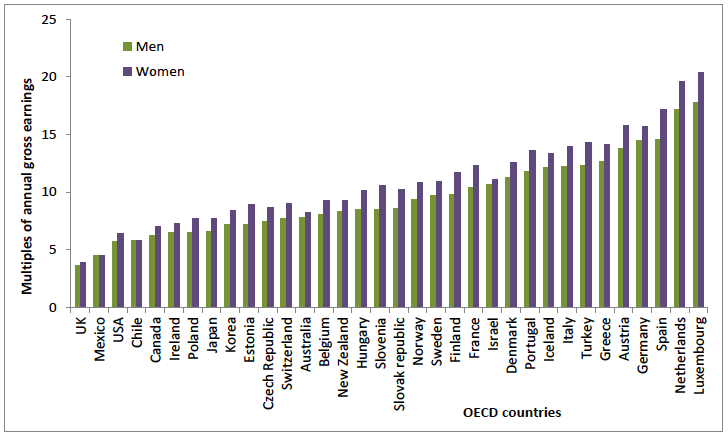
OECD (2016), Gross pension wealth (indicator). doi: 10.1787/62cdd9d3-en (Accessed on 23 June 2016)
Figure 31: OECD countries with a pensions gap
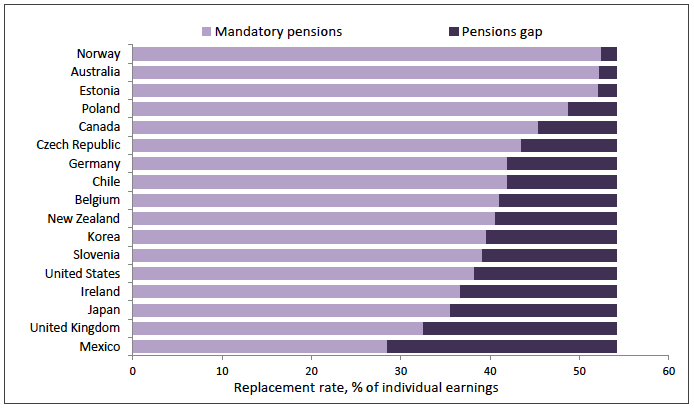
Source: OECD (2013), Pensions at a Glance 2013: Retirement-Income Systems in OECD and G20 Countries
Contact
There is a problem
Thanks for your feedback